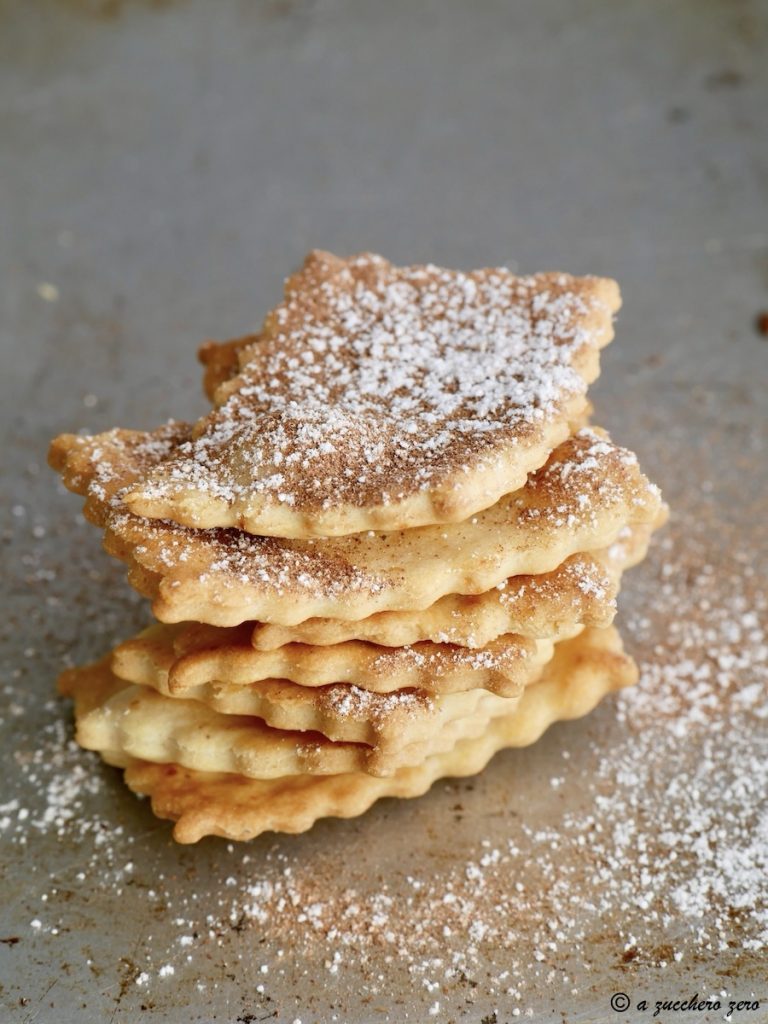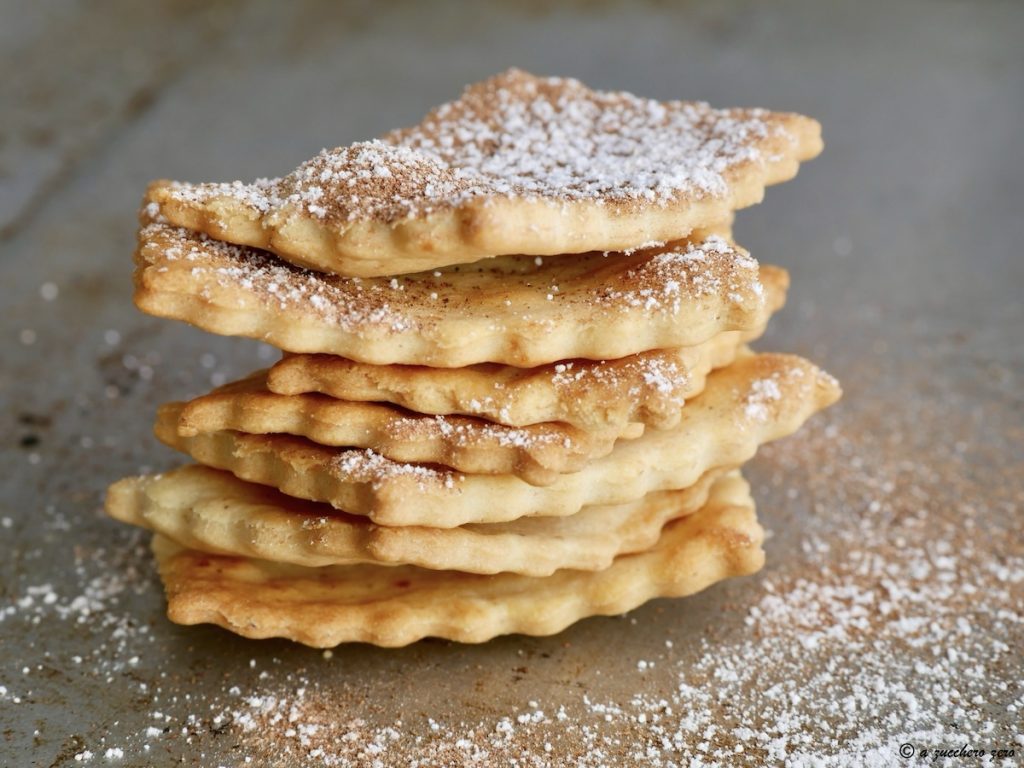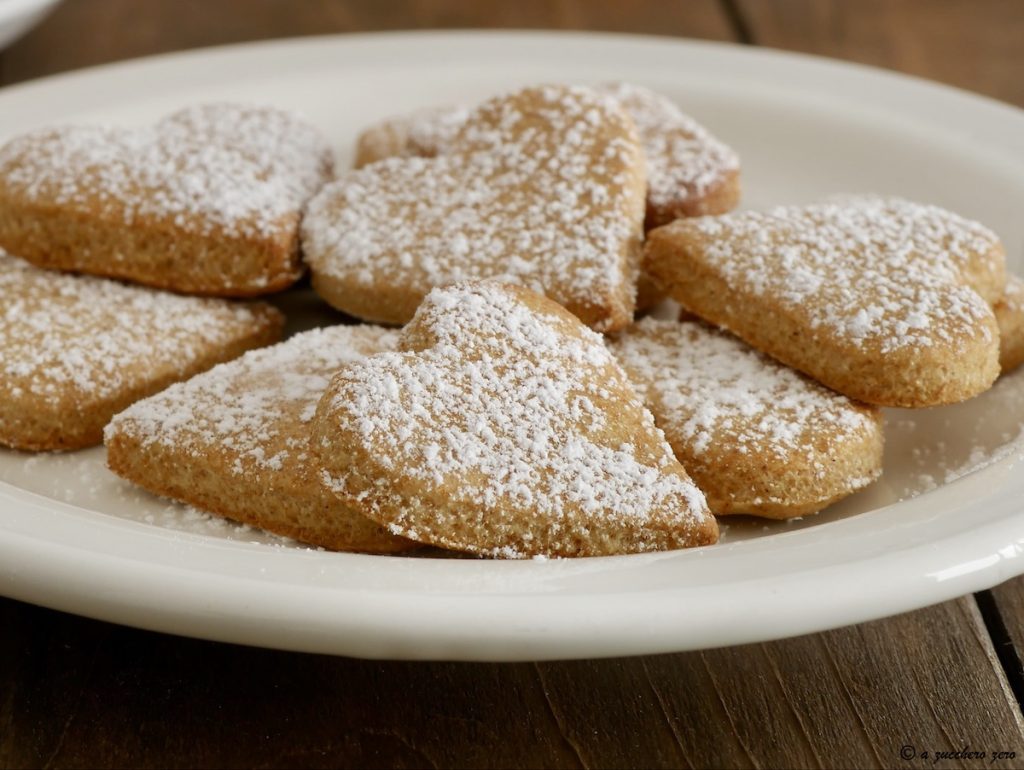The low glycemic index chiacchiere is a simple recipe.
Foreword
The low glycemic index chiacchiere are an alternative and naturally cannot be as thin and bubbly as traditional chiacchiere.
I used the low glycemic index mix [molino spadoni] based on type 1 flour and resistant starch, rich in fiber and protein.
These are chiacchiere without butter, milk, and eggs with ricotta.
These are sugar-free chiacchiere in the dough [just a drop of liquid sweetener added to the ricotta].
These are baked chiacchiere.
Light, crispy, and flaky, and even with some bubbles!
It is advisable to prepare this type of dough in small quantities and consume it within one or two days to best enjoy its characteristics because, naturally, due to the lack of certain ingredients, they tend to lose their crispness.
My dough is really small; if you feel appropriate, double or multiply the quantities of all ingredients.
The Carnival chiacchiere are also called bugie or crostoli, frappe or cenci.

- Difficulty: Easy
- Cost: Affordable
- Preparation time: 20 Minutes
- Portions: 14 Pieces
- Cooking methods: Electric Oven, Air Frying
- Cuisine: Italian
Ingredients
My dough is really small; if you feel appropriate, double or multiply the quantities of all ingredients.
- 3/4 cup cow milk ricotta (1-2 days old, well-drained)
- 1 drop liquid sweetener (Diete.Tic)
- 3/4 cup low glycemic index flour (Molino Spadoni)
- 1/4 tsp baking powder
- as needed lemon zest (grated)
- 1 1/2 cups cow milk ricotta (1-2 days old, well-drained)
- 2 drops liquid sweetener (Diete.Tic)
- 1 1/2 cups low glycemic index flour (Molino Spadoni)
- 1/2 tsp baking powder
- as needed lemon zest (grated)
- cinnamon powder
- powdered sugar
- 1 pinch sweetener (powdered erythritol [zero calories])
Keep in mind:
• the absence of sugar affects its structure.
Therefore, my advice is to avoid changes to the ingredients, especially the type of semolina/flour used.
Suggested Tools
- 1 Chopper or Mixer
- 1 Bowl
- 1 Sieve
- 1 Spatula silicone
- 1 Cutting Board or Pastry Board
- 1 Rolling Pin
- Pasta Machine
- Biscuit Cutters with Fluted Edges
- 1 Fluted Pastry Wheel
- 1 Ribbon Cutter
- 1 Baking Tray 10×11 in
- Parchment Paper
- 1 Brush silicone kitchen brush
Preparation
Pour into the mixer:
• the ricotta;
• the liquid sweetener or your usual one;
and blend.Pour into a bowl:
• the low glycemic index flour;
• the sifted baking powder;
• the blended ricotta;
• the grated lemon or orange zest;
and start mixing the dough with a silicone spatula.Continue kneading with your hands so that the flour and ricotta blend well.
Transfer the dough to a cutting board or a pastry board and continue working it for a few minutes.
The result is a very elastic dough.Roll out the dough with a rolling pin or pasta machine – Nonna Papera.
Fold it and roll out, repeat 2-3 times, then proceed with the final rolling.
The thinner your chiacchiere, the crunchier they will be.Cut your chiacchiere [hearts, traditional shape, streamers] using biscuit cutters or a fluted pastry wheel or a pastry roller for tarts.
Line a baking tray with parchment paper and arrange the chiacchiere on top.
For a more fried-like effect, brush with a little extra virgin olive oil or sunflower seed oil.Briefly preheat the oven.
Bake at 356°F (180°C) for about 15-20 minutes in a ventilated oven until evenly golden.
Temperatures and times may vary from oven to oven and depending on the thickness of the chiacchiere.Finish with a sprinkle of cinnamon mixed with powdered sugar or powdered erythritol [zero calories], or dip them in melted dark chocolate.
Your low glycemic index chiacchiere are ready.
Enjoy your meal!

Thinner and bubblier
I rolled out my chiacchiere with a rolling pin; to achieve a thinner thickness, use the pasta machine – Nonna Papera.
Additionally, folding and passing the sheet multiple times can also produce some bubbles.You can cook low glycemic index chiacchiere in an air fryer.
Follow the instructions [temperature and times] provided in your appliance’s user manual.You can use the same dough to prepare savory chiacchiere.
The low glycemic index chiacchiere with ricotta dough is a light and versatile dough perfect for making cannoli and other mini pastry recipes to fill.
Variations
Keep in mind:
• the absence of sugar affects its structure.
Therefore, my advice is to avoid changes to the ingredients, especially the type of semolina/flour used.
FAQ (Frequently Asked Questions)
They are not thin and bubbly!
The low glycemic index chiacchiere are an alternative and naturally cannot be as thin and bubbly as traditional chiacchiere.
• the dough with the low glycemic index mix is very elastic and generally difficult to roll out very thinly!
• frying is one of the components that helps form bubbles, and our chiacchiere are baked.
• the alcohol component contributes to bubble formation, and our chiacchiere lack it.
I rolled out my chiacchiere with a rolling pin; to achieve a thinner thickness, use the pasta machine – Nonna Papera.
Additionally, folding and passing the sheet multiple times can also produce some bubbles.How to substitute ricotta in doughs?
You can substitute ricotta with:
• another light spreadable fresh cheese [cottage cheese, ricotta, Philadelphia] or plant-based ricotta for a vegan diet;
• low-fat plain yogurt or Greek yogurt.How to store chiacchiere?
It is advisable to prepare this type of dough in small quantities and consume it within one or two days to best enjoy its characteristics because, naturally, due to the lack of certain ingredients, they tend to lose their crispness.
Store the chiacchiere in a tin or glass container with an airtight seal.
The chiacchiere keep for 1-2 days.


